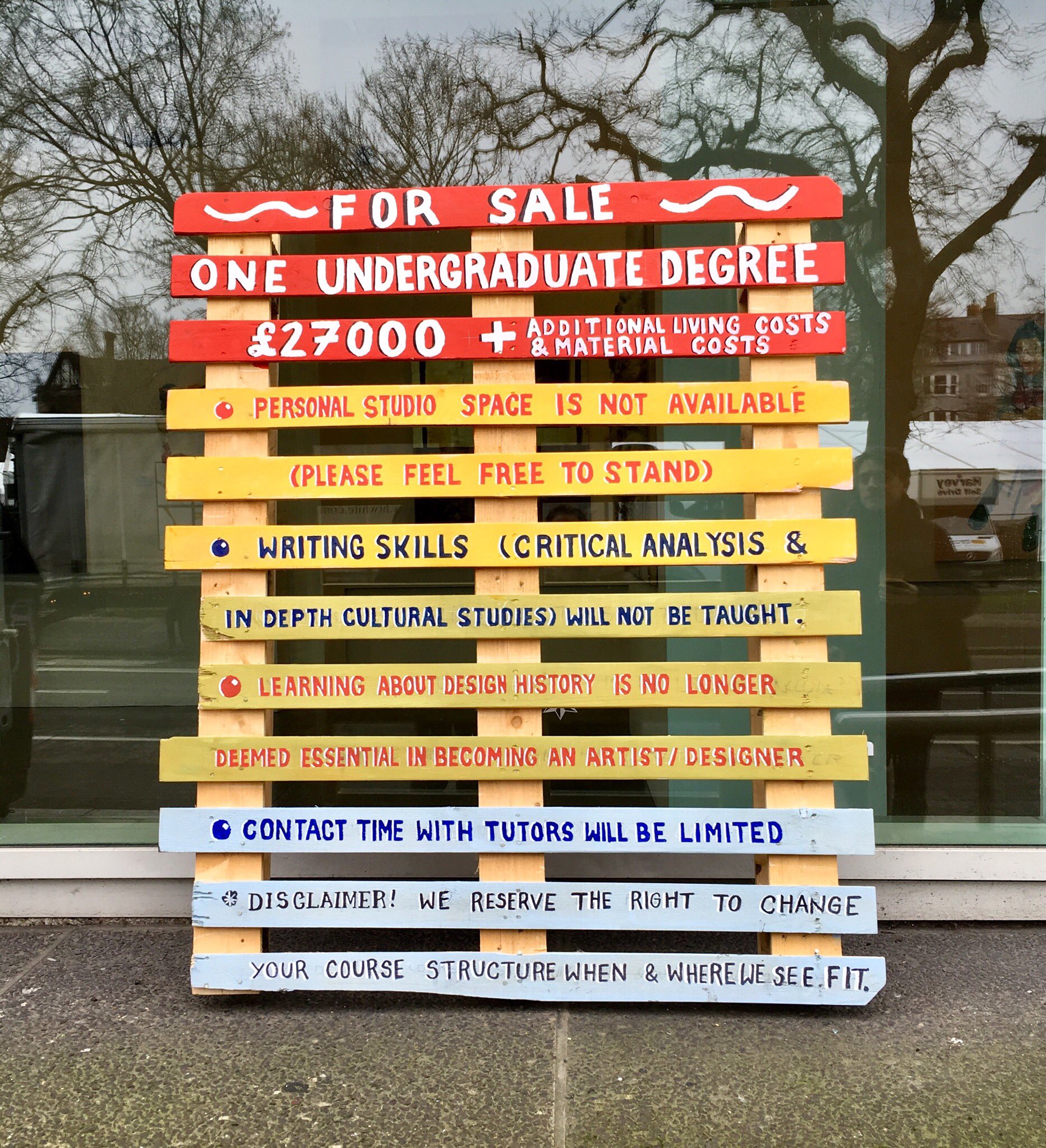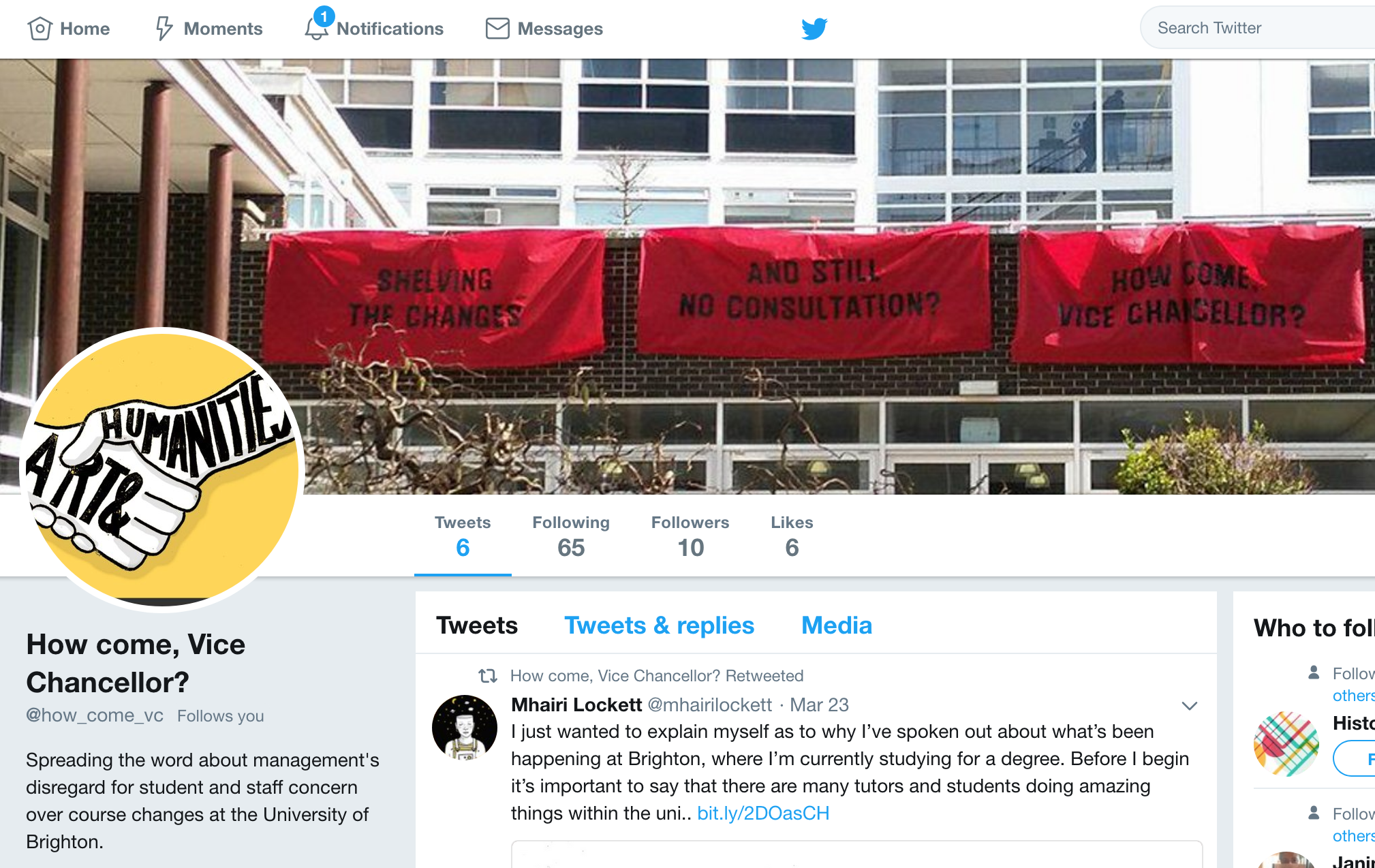I teach Cultural and Critical Studies to Graphic Design and Illustration students at the University of Brighton and was suitably delighted when, on my way to give a lecture, I spotted this piece of ‘pallet protest art’. An Illustration student, Mhairi Lockett, created this message, so I invited her to tell us more in a guest blog.
Why did the University of Brighton lock up a student’s protest art?
by Mhairi Lockett
It is soon to be the May Festival here in Brighton and the Guest Director this year is Illustrator, David Shrigley. One of the themes of the Festival is protest art, this is timely as 2018 marks the 50th year since the student protests in Paris. As a third year student of Illustration at the University of Brighton, I have been moved to make my own protest art — pallet protest art.
On Wednesday 14 February 2018, I placed a pallet outside the University of Brighton Grand Parade Campus, on an interview day when prospective Illustration students were on site. It read: ‘FOR SALE: ONE UNDERGRADUATE DEGREE: £27,000. Personal studio space is not available (please feel free to stand). Writing skills (critical analysis and in depth Cultural Studies) will not be taught. Learning about Design History is no longer deemed essential in becoming an artist/designer. Contact time with tutors will be limited. Disclaimer! We reserve the right to change your course structure when and where we see fit.’
After a few hours I was asked to remove the pallet, which I did. I put it in the third year shared studio space only to find out the following day that it had disappeared — locked in a store cupboard in the basement of the Grand Parade building.
As a third year student studying Illustration at the University, my action wasn’t a rash rebellious statement intended to tarnish the University’s name, but an attempt to bring to light some of the issues currently affecting the School of Art at the University of Brighton.
Under the term ‘Curriculum Design Review’, the management of the School of Art are proposing major changes to the structure of courses and methods of assessment throughout the School. In the name of inclusivity, the newly proposed modules would make extended critical writing optional for some courses by introducing alternative methods of assessment.
Academic tutors who currently teach Cultural and Critical Studies to School of Art students, and run the modules that are subject to these changes, were not present at any of the meetings when management told students about the course changes. We have since found out these same tutors were actively excluded from any involvement in these changes, perhaps because they questioned the benefits of the changes early on, and saw that they could be detrimental.
As a third year Student Rep, I have spoken to many students and staff who have raised concerns about this and who are distressed by the proposed course changes. However, when we took these concerns to management, they were brushed aside and we were told our objections were unfounded. It is exhausting and frustrating being repeatedly told that critical writing skills are not important, by people who have benefitted from extended critical writing as an integral part of their own undergraduate education.
After speaking to academics and researchers from other universities I collected the following evidence, in support of keeping the extended writing project as an essential part of our art and design courses. The reduction of word length disadvantages students in the following ways: 1. Downplays the importance of writing within the university sector. 2. Reduces the allocation of time for academic research and thus for developing sufficient understanding of the academic field to which students belong. 3. Decreases the opportunities for students to develop the skills of written expression and communication of ideas.
The changes appear to give students more choice under an ‘agenda of inclusivity’. However, the new modules would actually create a system of ‘self-exclusion’, holding back some students from realising their innate but untapped ability to write critically and at length.
As someone who hadn’t written an extended essay since leaving school at 16, I never would have thought myself capable of writing a dissertation of over 6,000 words. Yet, with the support of the Cultural and Critical Studies academic tutors at the University that became possible, and during that process I gained an increased focus of direction and purpose for my own studio practice and work.
The module provides art and design students with the ability to understand current issues and their origins and to contextualise their own practice both historically and critically. In this current political climate, critical thinking is essential in order to understand issues raised around power, agency and change. Being taught academic research skills also provides students with the ability to work within multi-disciplinary teams.
In the 1960s and 1970s, historical and complementary studies were introduced as an essential element of the art and design curriculum, as part of a concerted drive to shift the student experience from one that had been largely vocational to one that would open up greater opportunities, better salaries and a wider recognition in the outside world through qualities later termed as ‘transferable skills’.
Surely the need for us to contextualise and articulate our work as artists and designers is still just as vital as it was in the last century? I would welcome an academic debate about the appropriateness of a dissertation in a university degree, but the way in which this change has been brought about has not been consultative, rigorous or enlightened.
Worryingly, these new modules have not been discussed transparently, with many students and staff not informed or sufficiently consulted about the details and consequences of the proposals. Indeed, many students are still unaware of the situation. Far too much responsibility has been placed on student representatives to relay information about the proposed course changes to staff and students.
If the University is pushing an agenda aligned with commercial goals then that makes us consumers, but in making such drastic changes to the course’s management it is actually bypassing our rights as both students and consumers under the law.
The message that the pallet carries appears to ring true for many university art and design courses across the UK. With the Government moving away from supporting creative subjects there has been a decrease in funding for art subjects resulting in diminished studio space, resources and contact time with tutors.
Students are currently collecting signatures in support of demands to be presented to University of Brighton management including the following: 1. As students, we want a transparent discussion with management and academic staff from the School of Art and School of Humanities about all of the issues mentioned above. This discussion should take place before the student body is called to vote on whether to adopt the proposed changes or not. This will require a halt in the process of signing off the course proposals. 2. We want management to acknowledge that the Course Student Rep system has failed in this process, and therefore minutes from SSCC meetings cannot be used as evidence for ‘unanimous’ student agreement in favour of the course changes. 3. Management’s conduct in this process has caused distress for both students and staff. We call on management to recognise this and seek ways of improving communication with students and staff.
Over just a few days 150-plus signatures have been collected from the student body. This follows on from a campaign launched in June 2017 by students on the Graphic Design and Illustration course at University of Brighton aimed at lowering the enrollment cap, to a number that is permissible to occupy the third year studio space. The students put forward the following statement: ‘At the moment the current course size, which will occupy the studio Room 350 in September, is not legally allowed to use the room as an entire group. This goes against the point of providing a studio and is very detrimental to the course and the students’ education. Unless the studio is remodelled or more studio space allocated there is no way the course can function with this many students.’
With fees increasing and the value of an arts education continually questioned, surely now is the worst time to remove the extended writing modules and fail to adequately provide sufficient studio space and resources for students on art and design courses at the University of Brighton? And perhaps locking a protest pallet in a cupboard in the basement of the University is not the best way to respond to the issues being raised.
And this is me, again….
Subsequently, Mhairi was interviewed by Sarah Dawood of Design Week, and you can read that article, here. Another protest, consisting of three red banners overlooking the courtyard at Grand Parade was unceremoniously binned by management, prompting a new Twitter feed, ‘How Come, Vice Chancellor?’ (@how_come_vc?), with the latest updates, for example, that the proposed changes are halted but there’s still no consultation…



